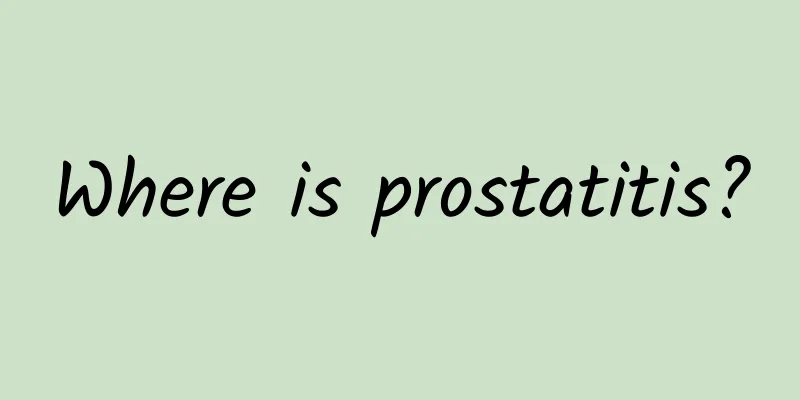Where is prostatitis?

|
When you have prostatitis, don't worry, because prostatitis often occurs near the male urethra. When it occurs, it is mostly caused by bacteria, accompanied by itching and pain. At this time, you can go to the hospital for treatment actively, and it can be cured. However, you should pay attention to developing good living habits. During the treatment period, it is best not to have sex. Your clothes should be changed and washed frequently and exposed to the sun for disinfection. Prostatitis refers to a prostate disease caused by a variety of complex reasons, with urethral irritation symptoms and chronic pelvic pain as the main clinical manifestations. Prostatitis is a common disease in urology, and ranks first among male patients under 50 years old in urology. Although the incidence of prostatitis is very high, its cause is still not very clear, especially non-bacterial prostatitis, so its treatment focuses on improving symptoms. In 1995, the National Institutes of Health (NIH) of the United States developed a new classification method for prostatitis, Type I: equivalent to acute bacterial prostatitis in the traditional classification method, Type II: equivalent to chronic bacterial prostatitis in the traditional classification method, Type III: chronic prostatitis/chronic pelvic pain syndrome, Type IV: asymptomatic prostatitis. Among them, non-bacterial prostatitis is far more common than bacterial prostatitis. Causes Only a few patients have an acute history, and most of them present with chronic, recurrent symptoms. The main pathogenic factors of type I and type II prostatitis are pathogenic infection, mainly Escherichia coli, Klebsiella, Proteus and Pseudomonas aeruginosa. Pathogens invade the prostate with urine, causing infection. Pathological anatomy confirms that prostatitis lesions are generally limited to the peripheral zone, where the glandular duct opens in the posterior urethra in the opposite direction of the vertical line of urine flow, which is easy to cause urine reflux, while the glandular ducts in the central zone and transitional zone are consistent with the direction of urine flow, and are not easy to be infected. The prostate has as many as 15 to 30 ducts opening on both sides of the seminal colliculus, and the prostate epithelium has a strong secretory function. The gland is small but the secretory function is strong, and the ducts are narrow, which causes the prostate to be compressed and blocked under the influence of various factors, which can easily cause congestion and secretion accumulation, thus creating conditions for infection. This is also the histological basis for the easy recurrence of prostatitis. Excessive sexual activity, excessive masturbation, long-term sitting, riding a bicycle, riding a horse, alcoholism, excessive spicy food, colds, etc. can all become its inducing factors. The pathogenesis of type III prostatitis is unknown, and its etiology is very complex and widely debated. Most scholars believe that its main causes may be pathogen infection, urination dysfunction, psychological factors, neuroendocrine factors, abnormal immune response, oxidative stress theory, lower urinary tract epithelial dysfunction, etc. Type IV prostatitis lacks research on its related pathogenesis, and may have some of the same causes and mechanisms as type III. Urine reflux in the prostate may be of great significance to the occurrence of various types of prostatitis. Recent studies have found that uric acid in urine not only stimulates the prostate, but can also precipitate into stones, block the gland ducts, and serve as a shelter for bacteria. These findings can explain that prostatitis syndrome is actually a common manifestation of multiple diseases, and the clinical manifestations are complex and varied, which can produce various complications or resolve on their own. Clinical manifestations Type I prostatitis often develops suddenly, with symptoms such as chills, fever, fatigue, and other systemic symptoms, accompanied by pain in the perineum and pubic area, frequent urination, urgency, rectal irritation, and even acute urinary retention. The clinical symptoms of type II and type III prostatitis are similar, mostly with pain and abnormal urination. Regardless of the type of chronic prostatitis, similar clinical symptoms can be manifested, collectively referred to as prostatitis syndrome, including pelvic and sacral pain, abnormal urination and sexual dysfunction. Pelvic and sacral pain is extremely complex. The pain is generally located above the pubic bone, lumbosacral region and perineum. Radiating pain can manifest as pain in the urethra, spermatic cord, testicles, groin, and inner side of the abdomen. It radiates to the abdomen and resembles acute abdominal pain. It radiates along the urinary tract and resembles renal colic, which often leads to misdiagnosis. Abnormal urination is manifested as frequent urination, urgent urination, painful urination, sluggish urination, bifurcated urine stream, dripping after urination, increased frequency of nocturia, and milky white secretions from the urethra after urination or during defecation. Occasionally, sexual dysfunction may occur, including decreased libido, premature ejaculation, painful ejaculation, weak erections, and impotence. Type IV prostatitis has no clinical symptoms and evidence of inflammation is only found during prostate examinations. Daily Health 1. Adhere to the treatment and do not change the medicine or treatment method at will during the treatment period, because the relief of symptoms often takes a period of time. Early treatment should be maintained for more than 2 weeks, and some infections need 8 to 12 weeks. If the medicine is changed at will, it is easy to cause bacterial flora imbalance or drug resistance, resulting in incomplete treatment. 2. Have regular sex life, cannot hold back ejaculation, do not masturbate frequently, and avoid unclean sexual intercourse. 3. Correctly understand prostatitis, maintain a good attitude, and reduce psychological pressure to avoid exaggerating symptoms and causing dizziness, memory loss, anxiety, suspicion, insomnia and other symptoms. 4. Drink plenty of water, urinate frequently, keep bowel movements smooth, and insist on hot water sitz baths or hot water bags for the perineum. 5. Avoid smoking, drinking, and spicy food. 6. Avoid sitting for long periods of time, avoid riding a bicycle for long periods of time, insist on exercising, preferably jogging and more lower body exercises, and avoid strenuous exercise. |
<<: Causes and treatment of male baldness
>>: What medicine can cure prostatitis quickly? What medicine is best for prostatitis?
Recommend
Penis massage improves sexual function
As people's quality of life improves, they pa...
What is the reason for a large amount of semen each time?
In fact, many situations may occur during the eja...
What to eat for the secondary development of testicles
Many men do not develop well during the first tes...
Why do boys ejaculate immediately the first time?
It is normal for men to ejaculate immediately aft...
What are the dietary misunderstandings of men?
For many male friends, eating is a simple matter....
Fufang Xuanju Capsules for the treatment of premature ejaculation
The black ju capsule of spiny seed is a tradition...
Exercise can treat impotence and other problems
Are there any other methods besides physical exer...
What are some ways for men to improve their sexual ability?
Generally speaking, men's sexual ability begi...
How long does sperm live in the body?
The combination of male sperm and female egg can ...
Causes of pimples under the scrotum
Some people have seen and experienced pimples und...
What are the effects of high estradiol in men? Men must know
The level of male estradiol has a huge impact on ...
What is hypothyroidism? How to take care of it?
The thyroid gland is the largest endocrine gland ...
There is a mysterious reason why men can't lift their heads
The stress and worries in men's lives have ca...
What to do with mild impotence and premature ejaculation
Male friends want to show their masculine charm, ...
There is a lot of dander on the glans and it smells bad
If there is a lot of dandruff on the glans and it...









